SHARING THE ROAD WITH OTHER VEHICLES
Large Trucks and RVs
To reduce the chance of having an accident with a large truck or RV, you must be familiar with a big rig’s physical capabilities and how they maneuver.
Braking
Large trucks take longer to stop than a car traveling at the same speed. The average passenger vehicle traveling at 55 mph can stop in about 400 feet. However, a large truck traveling at the same speed can take almost 800 feet to stop. Don’t move in front of a large truck and suddenly slow down or stop. The trucker will not be able to stop quickly enough to avoid crashing into you.
Turning
When any vehicle makes a turn, the rear wheels follow a shorter path than the front wheels. The longer the vehicle, the greater the difference. This is why big rig drivers must often swing wide to complete a right turn. When you follow a big rig, look at its turn signals before you start to pass. If you think the truck is turning left—wait a second and check the turn signals again. The driver may actually be turning right.

Shaded areas are the driver's blind spots.
Trucker's Blind Spots - The NO ZONE
Passenger vehicle drivers incorrectly assume that a trucker can see the road better because he or she is higher off the road. While truckers do have a better forward view and bigger mirrors, they still have serious blind spots and your vehicle can get lost in those blind spots. You block the trucker’s ability to take evasive action to avoid a dangerous situation if you stay in those blind spots. Generally speaking, if you can’t see the truck driver in his or her side mirror, he or she can’t see you. These blind spots are often called the “NO ZONE.”
Maneuverability
Trucks are designed to transport products and they are not as maneuverable as passenger vehicles. Large trucks have longer stopping and starting distances. They take more space for turns and they weigh more. On multilane highways and freeways, large trucks usually stay in the center portion of the lane to help the flow of traffic. This also increases the trucker’s options in case he or she must change lanes to avoid a hazard.
Avoid these mistakes when driving around large trucks.
- Cutting off a truck in traffic or on the highway to reach an exit or turn. Cutting into the open space in front of a truck is dangerous. Trying to beat a truck through a single lane construction zone, for example, removes the truck driver’s cushion of safety and places you in danger. Slow down and take your turn entering the construction zone. Don’t speed up to pass a truck so you can exit the roadway. Take a moment to slow down and exit behind a truck—it will only take you a few extra seconds.
- Don’t linger alongside a truck when passing. Always pass a large truck on the left side and after you pass the truck, move ahead of it. Don’t linger, because if you do you make it very difficult, if not impossible, for the trucker to take evasive action if an obstacle appears in the road ahead.
- Following too closely or tailgating. When you follow so closely behind a truck that you cannot see the truck driver’s side view mirrors, the trucker has no way of knowing you are there. Tailgating a truck, or any vehicle, is dangerous because you take away your own cushion of safety. Where will you go when the vehicle in front of you stops quickly?
- Never underestimate the size and speed of an approaching tractor-trailer. A large tractor-trailer often appears to be traveling at a slower speed because of its large size. Many passenger vehicle vs. large truck accidents take place at intersections because the passenger vehicle driver did not realize how close the truck was or how quickly it was traveling.
California Driver Handbook
Sharing the Road with Other Vehicles
Buses, Streetcars, and Trolleys
Do not drive through a safety zone, which is a space set aside for pedestrians and marked by raised buttons or markers on a roadway.
When people are boarding or leaving a streetcar or trolley where there is no safety zone, stop behind the vehicle’s nearest door or vehicle platform and wait until the people have reached a safe place.
When a bus, streetcar, or trolley is stopped at a safety zone or at an intersection where traffic is controlled by a police officer or traffic signal, you may pass, as long as it is safe to do so, and at no more than 10 mph.
Do not overtake and pass any light rail vehicle or streetcar on the left side, whether it is moving or standing.
Exceptions:
- When you are on a one-way street.
- When the tracks are so close to the right side that you cannot pass on the right.
- When a traffic officer directs you to pass on the left.
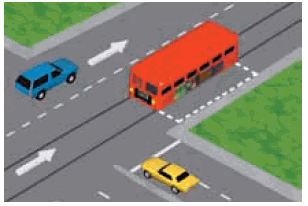
Safety Zones are marked by dotted white lines
Light Rail Vehicles
Light rail vehicles have the same rights and responsibilities on public roadways as other vehicles. Although everyone must follow the same traffic laws, light rail vehicles, because of their size, require exceptional handling ability.
Safely share the road with light rail vehicles by:
- Being aware of where light rail vehicles operate. Buildings, trees, etc., cause blind spots for the trolley operator.
- Never turning in front of an approaching light rail vehicle.
- Maintaining a safe distance from the light rail vehicle if it shares a street with vehicular traffic.
- Looking for approaching light rail vehicles before you turn across the tracks. Complete your turn only if a signal (if installed) indicates you may proceed.
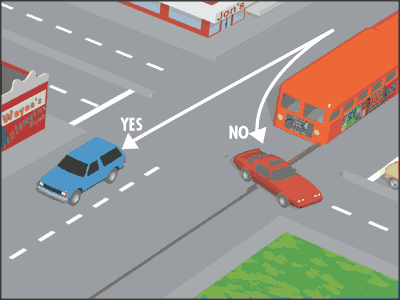
Do not turn in front of light rail vehicles
NOTE: Light rail vehicles can interrupt traffic signals, so do not proceed until the signal light indicates you may.
Emergency Vehicles
You must yield the right of way to any police car, fire engine, ambulance, or other emergency vehicle using a siren and red lights. Drive as close to the right edge of the road as possible and stop until the emergency vehicle(s) has passed. However, never stop in an intersection. If you are in an intersection when you see an emergency vehicle, continue through the intersection and then drive to the right as soon as you can and stop. Emergency vehicles often use the wrong side of the street to continue on their way. They sometimes use a loud speaker to talk to drivers blocking their path.
You must obey any traffic direction, order, or signal by a traffic or police officer or a fire fighter even if it conflicts with existing signs, signals, or laws.
It is against the law to follow within 300 feet of any emergency vehicle which is answering an emergency call.
If you drive for sight-seeing purposes to the scene of a fire, accident, or other disaster you may be arrested. Casual observers interfere with the essential services of police, fire fighter, ambulance crews, or other rescue or emergency personnel.
California Driver Handbook
Sharing the Road with Other Vehicles
SLOW MOVING VEHICLES
Some vehicles are not designed to keep up with the speed of traffic. Look for these vehicles and adjust your speed before you reach them.
Farm tractors, animal-drawn carts, and road maintenance vehicles usually travel 25 mph or less. Slow moving vehicles have an orange triangle on the back. It looks like this sign.


Also, be aware that large trucks and small, under powered cars lose speed on long or steep hills and they take longer to get up to speed when entering traffic.
Certain other types of slow moving motorized vehicles (such as wheelchairs, scooters and golf carts) may legally operate on public roads. Adjust your speed accordingly.
ANIMAL DRAWN VEHICLES
Horse drawn vehicles and riders of horses or other animals are entitled to share the road with you. It is a traffic offense to scare horses or stampede livestock. Slow down or stop, if necessary, and when requested to do so by the riders or herders.
MOTORCYCLES
Motorcyclists have the same rights and responsibilities as automobile drivers. While everyone must follow the same traffic laws, motorcyclists face unusual dangers because motorcycles are hard to see (many motorcycles keep their headlight on, even during daylight hours) and they require exceptional handling ability.
Follow these rules to respect the right-of-way and safely share the road with motorcyclists:
- When you change lanes or enter a major thoroughfare, make a visual check for motorcycles. Also use your mirrors. Motorcycles are small and they can easily disappear into a vehicle’s blind spots.
- Allow a four-second following distance. You will need this space to avoid hitting the motorcyclist if he or she falls.
- Allow the motorcycle a full lane width. Although it is not illegal to share lanes with motorcycles, it is unsafe.
- When you make a turn, check for motorcyclists and know their speed before turning.
- Remember that road conditions which are minor annoyances to you pose major hazards to motorcyclists. Potholes, gravel, wet or slippery surfaces, pavement seams, railroad crossings, and grooved pavement can cause motorcyclists to change speed or direction suddenly. If you are aware of the effect of these conditions and drive with care and attention, you can help reduce motorcyclist injuries and fatalities.
BICYCLES
Bicyclists on public streets have the same rights and responsibilities as automobile drivers. Respect the right-of-way of bicyclists because they are entitled to share the road with other drivers. Here are some critical points for drivers and cyclists to remember:
- Bicyclists:
- must ride in the same direction as other traffic, not against it.
- must ride in a straight line as near to the right curb or edge of the roadway as practical— not on the sidewalk.
- must make left and right turns in the same way that drivers do, using the same turn lanes.
- may legally move left to turn left, to pass a parked or moving vehicle, another bicycle, an animal, or to make a turn, avoid debris, or other hazards.
- may choose to ride near the left curb or edge of a one-way street.
- may use a left turn lane. If the bicyclist is traveling straight ahead, he or she should use a through traffic lane rather than ride next to the curb and block traffic making right turns.
- are lawfully permitted to ride on certain sections of freeways, when signs are posted. Be careful when approaching or passing a bicyclist on a freeway.
- Drivers must:
- look carefully for bicyclists before opening doors next to moving traffic or before turning right.
- safely merge toward the curb or into the bike lane.
- not overtake a bicyclist just before making a right turn. Merge first, then turn.
Turns for bicyclists
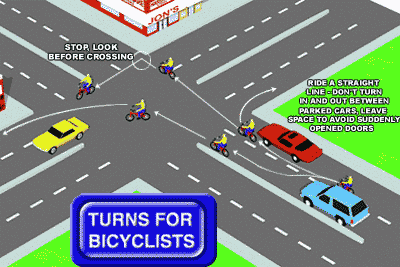
Intersections with special lanes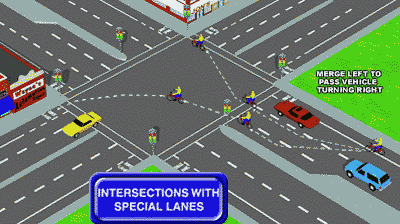
California Driver Handbook
Sharing the Road
Pedestrians Who Are Blind
Pedestrians using guide dogs or white canes with or without a red tip must be given the right of way at all times. These pedestrians are partially or totally blind, so be especially careful when turning corners or backing up.
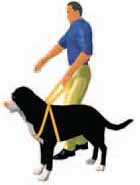
Here are some suggestion for helping pedestrians who are blind:
- Don’t stop your car more than five feet from the crosswalk. The blind pedestrian uses the sound of your engine as a guide, so drive up to the crosswalk to allow the person to hear you.
- Don’t give the blind pedestrian verbal directions. The blind pedestrian listens to all traffic sounds before deciding to cross the street.
- Don’t wait too long for the blind pedestrian to cross the street. If the person takes a step back and pulls in his or her cane, that’s a definite sign that you should go.
- Don’t turn right on red without looking first. Look for any pedestrian or other traffic first before starting your turn.
- Stop at all crosswalks where pedestrians are waiting.
- Don’t stop in the middle of a crosswalk. This forces the blind pedestrian to go around your car and into traffic outside of the crosswalk.
- Don’t block any sidewalk.
- Don’t honk at a blind person. The blind person has no idea who you are honking at and may be scared by the noise
Road Workers & Work Zones
Pay more attention where road work is being performed. Signs and message boards warn you of workers, slow moving equipment, and closed lanes ahead. Cones and/ or drums will direct you to open lanes. Merge as soon as possible without crossing the cones or drums. Reduce your speed and be prepared to slow down or stop for highway equipment.
The most common cause of motorist deaths and injuries in work zones is rear-end collisions. For your own safety and the safety of your passengers, remember to slow down, allow extra following room, merge early, expect sudden slowing or stopping, watch for drivers changing lanes at the last minute, and do not use your telephone while in the Cone Zone.
Keep your eyes on the road and vehicles ahead. Do not stop to watch the road work. Obey special signs or instructions from workers.
It’s for your own safety and the safety of road workers that you drive carefully through highway work zones. Remember to “Slow for the Cone Zone.”
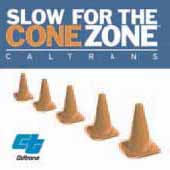
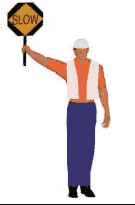
Double Fine Zones
Due to increased accidents, injuries, and fatalities, certain roads are designated as “Safety Enhanced-Double Fine Zones.” Fines are doubled in these areas and also in highway construction or maintenance zones when workers are present. (VC §42010)
Move Over & Slow Down
Effective January 1, 2007, drivers are required to Move Over and Slow Down when approaching a roadside emergency along a state highway or freeway. The law is designed to reduce the deaths of police officers, towtruck drivers, paramedics and other emergency personnel who are aiding stranded motorists. Use caution if lane changes are required.
California Driver Handbook
Sharing the Road With Other Vehicles
Vehicles With Hazardous Loads
Diamond shaped signs mean that the load on the truck is potentially dangerous (gas, explosives, etc.). CHP or fire department officers know what to do if the load is accidentally spilled. Vehicles which display these signs, are required to stop before crossing railroad tracks.

Source: (California Driver Handbook) http://www.dmv.ca.gov
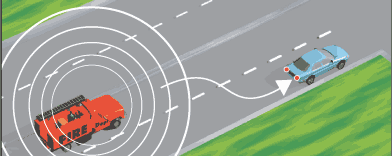

No comments:
Post a Comment